Your Call?
Which of today’s two sharp, tight flight images do you like best? Why? I have a clear choice.
What’s Up?
On Friday, I got some work done on my 2021 taxes and got into the pool for my 1/2-mile swim for the first time in more than a month. Older daughter Jennifer and her husband Erik and younger daughter Alissa and her son, Idris, came over for dinner. Lissy and my grandson came down from Long Island for a short visit. Tuna and Brussels sprouts were on the menu. We began on the pool deck but were driven inside by a violent thunderstorm right over the house.
Today is Saturday 3 September 2022. I’ll be taking an early rope flow walk and then getting back to work on my taxes. Wherever you are, and whatever you are doing, I hope that you too have a great day. This blog post took about an hour to prepare and makes one hundred sixty-two days in a row with a new one.
Please remember to use the B&H and Amazon links that are found on most blog pages and to use the BIRDSASART discount code at checkout when purchasing your new gear from Bedfords to get 3% back on your credit card and enjoy free second-day air FedEx. Please, also, consider joining a BAA IPT. You will be amazed at how much you will learn!
Follow me on Instagram here. I am trying to feature both new and old images, especially images that have not appeared recently on the blog. Or search for birds_as_art.
BIRDS AS ART Image Optimization Service (BAA IOS)
Send a PayPal for $62.00 to birdsasart@verizon.net or call Jim at 863-692-0906 and put $62.00 on your credit card. Pick one of your best images and upload the raw file using a large file sending service like Hightail or DropBox and then send me the link via e-mail. I will download and save your raw file, evaluate the exposure and sharpness, and optimize the image as if it were my own after converting the raw file in Adobe Camera Raw. Best of all, I will make a screen recording of the entire process and send you a link to the video to download, save and study.
Induro GIT 304L Price Drop
Amazingly, we have two, brand-new-in-the-box Induro GIT 304L tripods in stock. They are $699.00 each (were $799.00) and the price now includes the insured ground shipping to the lower 48 states. Weekday phone orders only: 863-692-0906. Order yours here while they last.
|
|
|
This image was also created on 19 January 2022 on a San Diego IPT at La Jolla, CA.. While standing at full height, I used the no-longer available (except from BAA) Induro GIT 304L tripod/Levered-Clamp FlexShooter Pro-mounted Sony FE 600mm f/4 GM OSS lens and The One, the Sony Alpha 1 Mirrorless digital camera. ISO 800. Exposure was determined via Zebras with ISO on the rear dial: 1/2000 sec. at f/4 (wide open). RawDigger showed that the raw file brightness was perfect. AWB at 9:49:50 on a rare cloudy morning. Tracking: Zone/AF-C was active at the moment of exposure and performed perfectly. Be sure to click on the image to enjoy the larger version. Image #1: Brown Pelican Pacific race adult in flight |
Tight Pelican Flight Why
Sharp, tight flight shots will always reveal detail, color, and patterns that we do not see in wider flight images. They will impress your friends. And they are fun to make, and fun to crop. Note: both of today’s images were relatively small crops.
|
|
|
This image was also created on 19 January 2022 on a San Diego IPT at La Jolla, CA.. While standing at full height, I used the no-longer available (except from BAA) Induro GIT 304L tripod/Levered-Clamp FlexShooter Pro-mounted Sony FE 600mm f/4 GM OSS lens and The One, the Sony Alpha 1 Mirrorless digital camera. ISO 800. Exposure was determined via Zebras with ISO on the rear dial: 1/2000 sec. at f/4 (wide open). RawDigger showed that the raw file brightness was perfect. AWB at 9:49:50 on a rare cloudy morning. Tracking: Zone/AF-C was active at the moment of exposure and performed perfectly. Be sure to click on the image to enjoy the larger version. Image #2: Brown Pelican Pacific race adult in flight |
Tight Pelican Flight How
When working with a variety of dSLRs for several decades, sharp, tight, flight images were a rarity because the AF systems were simply not up to the task. With birds angling toward or right at us, most of the images were sharp on the feet, not on the birds’ eyes. But the AF systems on the top-of-the-line mirrorless camera bodies are — most of the time, able to track flying subjects quite well, even when they are flying toward us, and even as they get larger and larger in the frame.
Even though these mirrorless cameras offer AF across the full screen and can track the birds’ eyes anywhere in the frame, keeping the subject somewhere near the center of the frame will improve your results. Can you say “Operator Error”? Almost all quality telephoto lenses have limit range switches. For most flight photography, I recommend keeping that switch at the Not Full setting as initial focusing acquisition will be quicker. Why? The lens does not have to focus down to the lens’s minimum focusing distance (MFD) (and then ratchet back to the subject to find it). If the birds are flying at you and are getting closer and closer, you will need to remember to switch (sorry for the pun) to the Full setting so that the system can continue to track the bird right down to the MFD.
Old habits are, however, hard to break. It takes practice (and a good bit of confidence in your gear) to hold the shutter button down long after the bird has filled the frame. I am still working on that. I look forward to practicing this skill on my 5-week San Diego visit. Do consider joining me on one of the three IPTs.
|
|
|
This all-new card includes images created on my JAN 2022 visit to San Diego. Click on the composite to enjoy a larger version. |
The 2022/23 San Diego Brown Pelicans (and more!) IPTs
San Diego IPT #1. 3 1/2 DAYS: WED 21 DEC thru the morning session on Saturday 24 DEC 2022. $2099.00. Deposit: $699.00. Limit: 6 photographers/Openings: 5.
San Diego IPT #2. 4 1/2 DAYS: SAT 7 JAN thru the morning session on WED 11 JAN 2023: $2699.00. Deposit: $699.00. Limit: 6 photographers/Openings: 3.
San Diego IPT #3: 3 1/2 DAYS: FRI 20 JAN thru the morning session on MON 23 JAN 2023: $2099.00. Deposit: $699.00. Limit: 6 photographers/Openings: 5.
Please e-mail for information on personalized pre- and post-IPT sessions.
Join me in San Diego to photograph the spectacular breeding plumage Brown Pelicans with their fire-engine red and olive green bill pouches; Brandt’s (nesting) and Double-crested Cormorants; breeding plumage Wood and Ring-necked Ducks; other duck species possible including Lesser Scaup, Redhead, Northern Shoveler and Surf Scoter; a variety of gulls including Western, California, and the gorgeous Heermann’s, all in full breeding plumage; shorebirds including Marbled Godwit, Willet, Sanderling and Black-bellied Plover; many others are possible including Least, Western, and Spotted Sandpiper, Whimbrel, Black and Ruddy Turnstone, Semipalmated Plover, and Surfbird; Harbor Seals and California Sea Lions (both depending on the current regulations and restrictions). And as you can see by studying the IPT cards, there are some nice bird-scape and landscape opportunities as well. Not to mention a ton of excellent flight photography opportunities and instruction.
Please note: where permitted and on occasion, ducks and gulls may be attracted (or re-located) with offerings of grains or healthy bread.
|
|
|
San Diego offers a wealth of very attractive natural history subjects, including and especially the Pacific race of California Brown Pelican. With annual visits spanning more than four decades, I have lots of photographic experience there … Click on the composite to enjoy a larger version. |
Learning Exposure, Whether You Like It Or Not
Whether you like it or not, we will be beating the subject of exposure like a dead horse. In every new situation, you will hear my thoughts on exposure along with my thoughts on both Nikon and Canon histograms and SONY Zebras. Whether you like it or not, you will learn to work in manual mode so that you can get the right exposure every time (as long as a bird gives you ten seconds with the light constant). Or two seconds with SONY zebras … And you will learn what to do when the light is changing constantly. What you learn about exposure will be one of the great takeaways on every IPT.
|
|
|
Though the pelicans will be the stars of the show on this IPT, there will be many other handsome and captivating subjects in wonderful settings. Click on the composite to enjoy a larger version. |
It Ain’t Just Pelicans
With gorgeous subjects just sitting there waiting to have their pictures taken, photographing the pelicans on the cliffs is about as easy as nature photography gets. With the winds from the east almost every morning there is usually some excellent flight photography as well, often with 70-200mm lenses! And the pelicans are almost always doing something interesting: preening, scratching, bill pouch cleaning, or squabbling. And then there are those crazy head throws that are thought to be a form of intra-flock communication. You will be guided as to how to make the best of those opportunities. Depending on the weather, the local conditions, and the tides, there are a variety of other fabulous photo chances available in and around San Diego.
|
Did I mention that there are lots of great birds and natural history subjects in San Diego in winter? Click on the composite to enjoy a larger version. |
The San Diego Details
These IPTs will include four or five 3-hour morning photo sessions, three or four 1 1/2-hour afternoon photo sessions, and three or four working brunches that will include image review and Photoshop sessions. On rare cloudy days, we may — at the leader’s discretion, stay out in the morning for a long session and skip that afternoon. To ensure early starts, breakfasts will be your responsibility. And so that we can get some sleep, dinners will be on your own as well. In the extremely unlikely event that Goldfish Point is closed due to local ordinance (or whimsy) — that has never happened in the past fifty years, I will of course do my very best to maximize our photographic opportunities.
|
|
|
San Diego offers a wealth of very attractive natural history subjects, including and especially the Pacific race of California Brown Pelican. With annual visits spanning more than four decades, I have lots of photographic experience there … Click on the composite to enjoy a larger version. |
Deposit Info
A $599 deposit is required to hold your slot for one of the 2022/23 San Diego IPTs. You can send a check (made out to “BIRDS AS ART”) to us here: BIRDS AS ART, PO Box 7245, Indian Lake Estates, FL, 3385, or call Jim or Jennifer at the office with a credit card at 863-692-0906. Your balance, payable only by check, is due three months before the trip.
|
Variety is surely the spice of life in San Diego. Click on the composite to enjoy a larger version. |
Getting Up Early and Staying Out Late
On all BIRDS AS ART IPTS including and especially the San Diego IPT, we get into the field early to take advantage of unique and often spectacular lighting conditions and we stay out late to maximize the chances of killer light and glorious sunset silhouette situations. We often arrive at the cliffs a full hour before anyone else shows up to check out the landscape and seascape opportunities.
Typos
With all blog posts, feel free to e-mail or to leave a comment regarding any typos or errors.

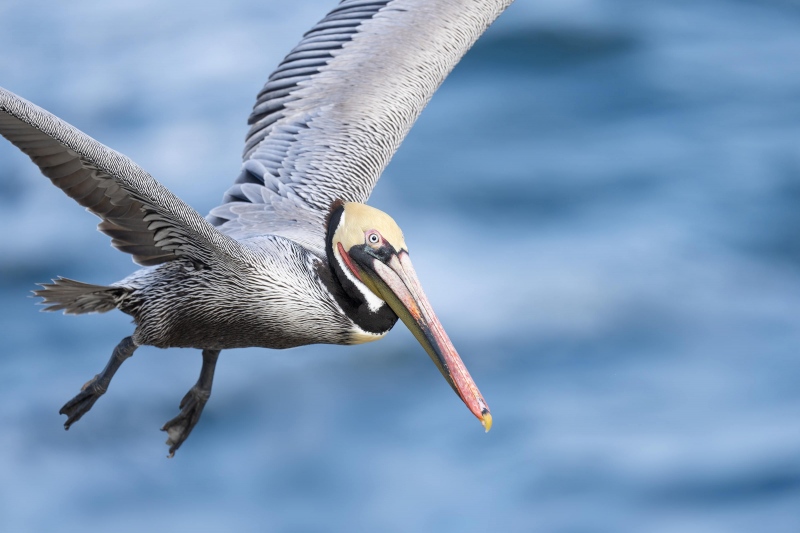
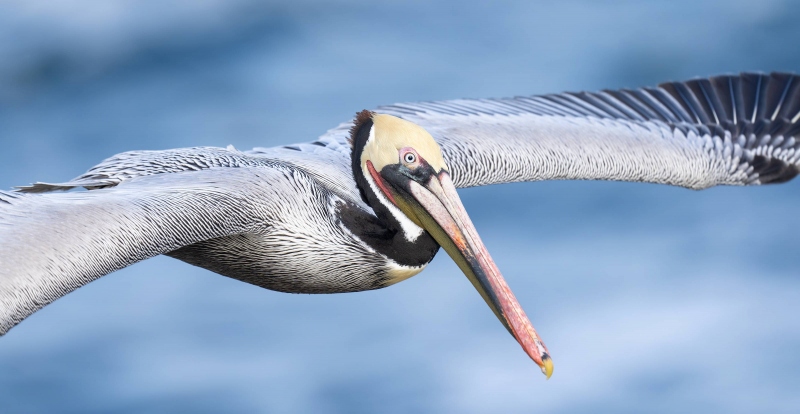
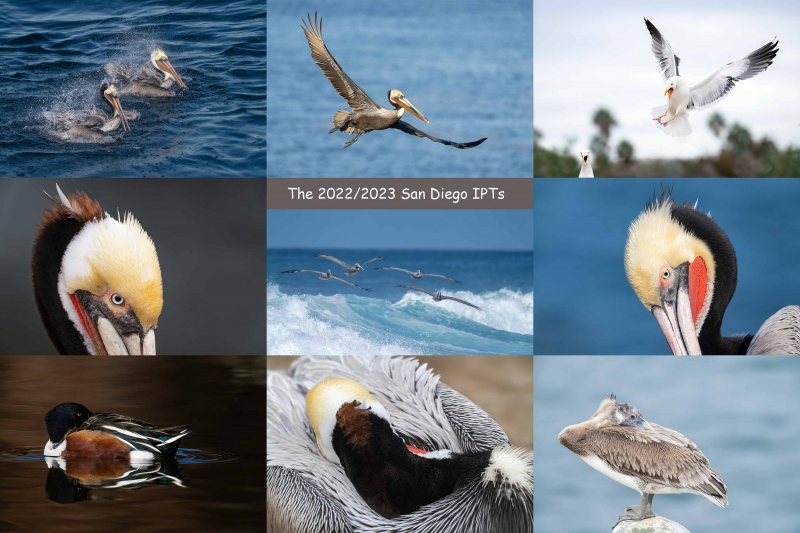
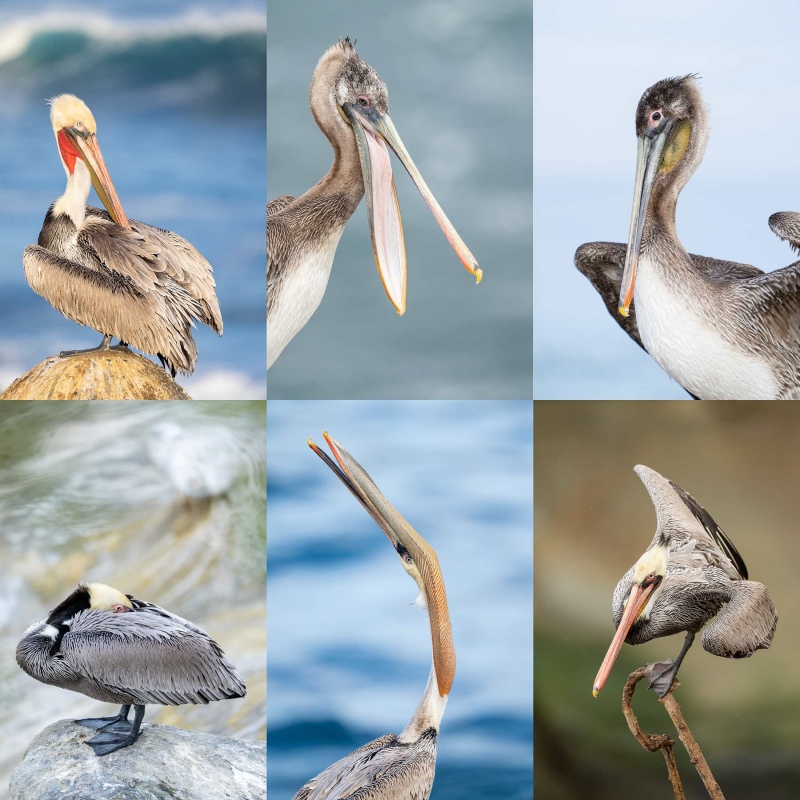
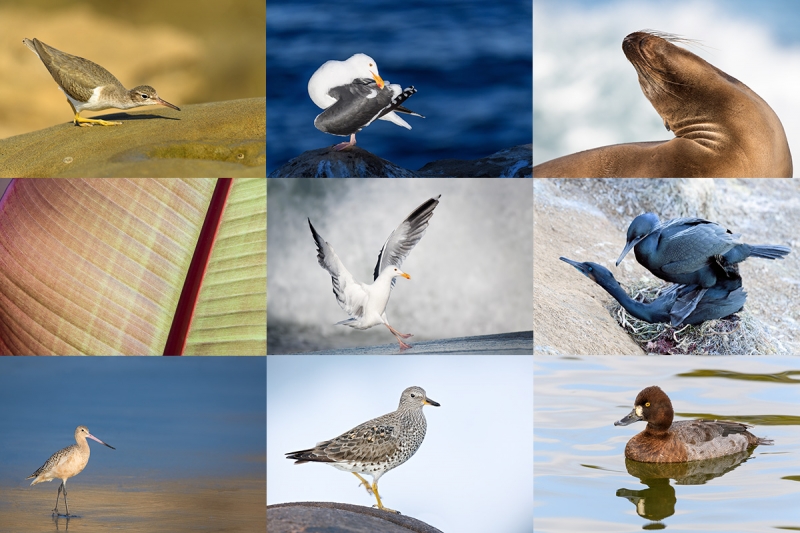

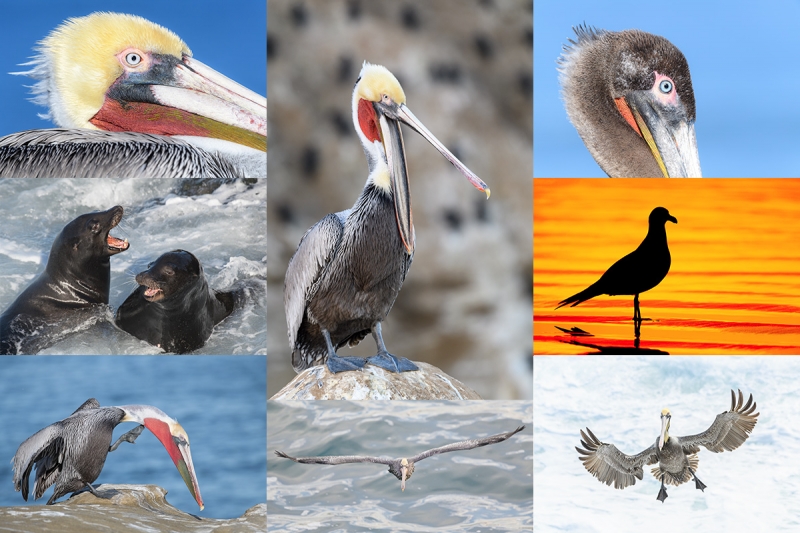














#2 is my favourite, I love the wide screen (panorama) format!
I like the first one, it gives more the impression of movement
#1 for me. I like the way the bird fills the frame but leaves enough negative space to give the sense of movement. The upward wing position is nice and allowing the viewer to see both the top of one wing and the bottom rows of feathers on the other wing. Very nice photo.
#1, “V’s” are better than straight lines!
I love the pose (head and wing positions, etc) in image #1 for many species (I’m thinking waders and shorebirds). I really prefer image #2 for a pelican. Growing up at the beach, I’ve watched a lot of pelicans and image #2 just draws me in. It “makes sense” to me, if you know what I mean.